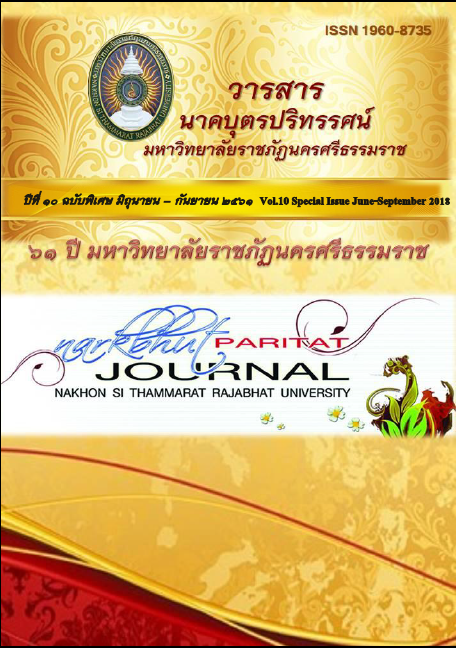กระบวนการพัฒนาเชื้อเพลิงชีวมวลภาคครัวเรือนเพื่อลดการใช้แก๊สหุงต้ม The Development Process of Household Biomass Energy for Reduction Using Cooking Gas
Main Article Content
Abstract
Abstract
The present study aimed 1) to study the process of developing household biomass fuel to reduce the use of cooking gas at Ban Khlongkhian Sufficiency Economy Community in Kapang Sub-district and 2) to pass on this knowledge to people who were interested in developing household biomass fuel in order to minimize using cooking gas.
The instruments for data collection included a survey, an observation, a participant interview, non-participant interview and a group seminar. The findings show that:
- There were many types of wood in Kasom Community, such as wood from fruit trees, stick, grass, wood from rubber trees and from wild trees. This wood sometime became garbage and pollution which were easy to find and priceless. Households in the community could use this wood as biomass fuel for their boiling, stewing and other ways of cooking that consumed a great number of gas in order to save money.
- Some people in Ban Khlongkhian Sufficiency Economy Community in Kapang Sub-district had been interested in and tried to reduce costs of cooking gases. When the researchers and the scholars went to the community, these people expressed their interest and wanted to learn to use this knowledge in their daily life. They conducted a small experiment and exchanged their experiences with the researcher team. This would lead to further continued cooperation on biomass utilization in households between the people and the researcher team.
Administrative recommendations
- Local administrative organizations should set the target area for cooking gas reduction and encourage people in that area to use gasification stoves in terms of budget and academic results. This way can result in a measurable reduced cost.
- The organizations which use a large amount of cooking gases should consider using gasification stoves. Comparing the expenses on using normal cooking gas with those of gasification stoves will reveal the differences between the expenses of the two kinds of gases.
Academic recommendations
- Studies on ways to save cost of cooking gases in medium and big organizations should be carried out for future application under the management team’s consideration.
- Graduate students should be encouraged to conduct a research study on other kinds of renewable energy.
Keyword : biomass fuel, household, reduction of cooking gas use
Article Details
Section
บทความวิจัย
References
กรมปศุสัตว์, “ปริมาณปศุสัตว์ในประเทศไทย”, ข้อมูลเศรษฐกิจปศุสัตว์ประจำปี 2543, หน้า 1-35.
กรมพัฒนาและส่งเสริมเชื้อเพลิง, 2543, “รายงานเชื้อเพลิงของประเทศไทย ปี 2543”, วารสารรายงานเชื้อเพลิงของประเทศไทย, ฉบับที่ 1, หน้า 2-10.
กรมพัฒนาและส่งเสริมเชื้อเพลิง, 2544, “อัตราส่วนวัสดุเหลือใช้ต่อผลผลิต แฟคเตอร์ของการใช้เป็นเชื้อเพลิงและแฟคเตอร์วัสดุเหลือใช้ที่ยังไม่มีการนำไปใช้”รายงานผลการสำรวจวัสดุเหลือใช้ทางการเกษตร.
ปัญญา เลิศไกร (2552) นวัตกรรมการปลูกปาล์มน้ำมันลุ่มน้ำปากพนัง นครศรีธรรมราช: วิทยานิพนธ์ ปรัชญาดุษฎีบัณฑิต สาขา การศึกษาเพื่อการพัฒนาท้องถิ่น มหาวิทยาลัยราชภัฏนครศรีธรรมราช
มานิตย์ อำพันธุ์, 2544, “ก๊าซชีวภาพและกระบวนการเกิด”, การอบรมการส่งเสริมก๊าซชีวภาพ ภาคเหนือ, 24 เมษายน 2544, สำนักงานส่งเสริมการเกษตรภาคเหนือ, จังหวัดเชียงใหม่,หน้า 1-43.
นิรันดร โพธิการนนท์, 2544, “มลภาวะจากน้ำเสียจากฟาร์มเลี้ยงสัตว์ขนาดกลาง”, เทคโนโลยีก๊าซ ชีวภาพเพื่อผลิตเชื้อเพลิงชีวมวลและบำบัดมลภาวะในฟาร์มเลี้ยงสัตว์, 2544 , หน้า 1-23.
สมชัย จันทร์สว่าง, 2545, “เทคโนโลยีแก๊สชีวภาพ”, เอกสารเผยแพร่เทคโนโลยีแก๊สชีวภาพ, สถาบันวิจัยและพัฒนาเทคโนโลยีแห่งมหาวิทยาลัยเกษตร, หน้า 2-38.
ศูนย์สารสนเทศการเกษตร,2544, “ปริมาณผลผลิตทางการเกษตร”, สถิติการเกษตรของประเทศไทย, กรุงเทพฯ, หน้า 12-30.
ศูนย์ส่งเสริมเชื้อเพลิงชีวมวล มูลนิธิเชื้อเพลิงเพื่อสิ่งแวดล้อม, 2545, “การใช้ประโยชน์จากก๊าซ ชีวภาพ”, บทความด้านเชื้อเพลิงชีวมวล ปี 2545, ฉบับที่ 1, หน้า 1-18.
ศูนย์ส่งเสริมเชื้อเพลิงชีวมวล มูลนิธิเชื้อเพลิงเพื่อสิ่งแวดล้อม, 2545, “ข้อมูลชีวมวลทั่วไป”, บทความด้านเชื้อเพลิงชีวมวล ปี 2545, ฉบับที่ 1, หน้า 3-42.
สมศักดิ์ เขตสมุทร, สมศักดิ์ เจนศิริศักดิ์และ บุญส่ง ศรีเจริญธรรม, 2540, “การเลี้ยงสัตว์น้ำในระบบเกษตร”, ความสำคัญของความหลากหลายทางชีวภาพในระบบเกษตร, ฉบับที่ 1, หน้า 3-22.
สำนักงานคณะกรรมการนโยบายเชื้อเพลิงแห่งชาติ, 2545, “การส่งเสริมการใช้เชื้อเพลิงจากชีวมวลของประเทศไทย”, วารสารนโยบายเชื้อเพลิง, ฉบับที่ 55, หน้า 1-30.
สำนักงานสำนักงานคณะกรรมการนโยบายเชื้อเพลิงแห่งชาติ, 2543, “เชื้อเพลิงเพื่อความเข้าใจ ใช้อย่างรู้คุณค่า พัฒนาสู่ความยั่งยืน”, พิมพ์ครั้งที่ 1, โรงพิมพ์คุรุสภา, กรุงเทพ, หน้า 2-4, 9, 11-24.
Danish International Development Assistance, 2003, “Biomass one-stop Clearing
House Energy for Environment Foundation”, Introduction to conversion of Biomass to Electricity and Thermal Energy, 17-18 March 2003, Bangkok, p. 54.
Energy Information Administration, 2001, “National Energy Education Development’s
Guidelines for Energy Education”, KIAKID Page, No. 1, pp. 1-10.
Regional Aquaculture Lead Center, 1981, “Integrated fish farming (I)”, pp. 1-55.
กรมพัฒนาและส่งเสริมเชื้อเพลิง, 2543, “รายงานเชื้อเพลิงของประเทศไทย ปี 2543”, วารสารรายงานเชื้อเพลิงของประเทศไทย, ฉบับที่ 1, หน้า 2-10.
กรมพัฒนาและส่งเสริมเชื้อเพลิง, 2544, “อัตราส่วนวัสดุเหลือใช้ต่อผลผลิต แฟคเตอร์ของการใช้เป็นเชื้อเพลิงและแฟคเตอร์วัสดุเหลือใช้ที่ยังไม่มีการนำไปใช้”รายงานผลการสำรวจวัสดุเหลือใช้ทางการเกษตร.
ปัญญา เลิศไกร (2552) นวัตกรรมการปลูกปาล์มน้ำมันลุ่มน้ำปากพนัง นครศรีธรรมราช: วิทยานิพนธ์ ปรัชญาดุษฎีบัณฑิต สาขา การศึกษาเพื่อการพัฒนาท้องถิ่น มหาวิทยาลัยราชภัฏนครศรีธรรมราช
มานิตย์ อำพันธุ์, 2544, “ก๊าซชีวภาพและกระบวนการเกิด”, การอบรมการส่งเสริมก๊าซชีวภาพ ภาคเหนือ, 24 เมษายน 2544, สำนักงานส่งเสริมการเกษตรภาคเหนือ, จังหวัดเชียงใหม่,หน้า 1-43.
นิรันดร โพธิการนนท์, 2544, “มลภาวะจากน้ำเสียจากฟาร์มเลี้ยงสัตว์ขนาดกลาง”, เทคโนโลยีก๊าซ ชีวภาพเพื่อผลิตเชื้อเพลิงชีวมวลและบำบัดมลภาวะในฟาร์มเลี้ยงสัตว์, 2544 , หน้า 1-23.
สมชัย จันทร์สว่าง, 2545, “เทคโนโลยีแก๊สชีวภาพ”, เอกสารเผยแพร่เทคโนโลยีแก๊สชีวภาพ, สถาบันวิจัยและพัฒนาเทคโนโลยีแห่งมหาวิทยาลัยเกษตร, หน้า 2-38.
ศูนย์สารสนเทศการเกษตร,2544, “ปริมาณผลผลิตทางการเกษตร”, สถิติการเกษตรของประเทศไทย, กรุงเทพฯ, หน้า 12-30.
ศูนย์ส่งเสริมเชื้อเพลิงชีวมวล มูลนิธิเชื้อเพลิงเพื่อสิ่งแวดล้อม, 2545, “การใช้ประโยชน์จากก๊าซ ชีวภาพ”, บทความด้านเชื้อเพลิงชีวมวล ปี 2545, ฉบับที่ 1, หน้า 1-18.
ศูนย์ส่งเสริมเชื้อเพลิงชีวมวล มูลนิธิเชื้อเพลิงเพื่อสิ่งแวดล้อม, 2545, “ข้อมูลชีวมวลทั่วไป”, บทความด้านเชื้อเพลิงชีวมวล ปี 2545, ฉบับที่ 1, หน้า 3-42.
สมศักดิ์ เขตสมุทร, สมศักดิ์ เจนศิริศักดิ์และ บุญส่ง ศรีเจริญธรรม, 2540, “การเลี้ยงสัตว์น้ำในระบบเกษตร”, ความสำคัญของความหลากหลายทางชีวภาพในระบบเกษตร, ฉบับที่ 1, หน้า 3-22.
สำนักงานคณะกรรมการนโยบายเชื้อเพลิงแห่งชาติ, 2545, “การส่งเสริมการใช้เชื้อเพลิงจากชีวมวลของประเทศไทย”, วารสารนโยบายเชื้อเพลิง, ฉบับที่ 55, หน้า 1-30.
สำนักงานสำนักงานคณะกรรมการนโยบายเชื้อเพลิงแห่งชาติ, 2543, “เชื้อเพลิงเพื่อความเข้าใจ ใช้อย่างรู้คุณค่า พัฒนาสู่ความยั่งยืน”, พิมพ์ครั้งที่ 1, โรงพิมพ์คุรุสภา, กรุงเทพ, หน้า 2-4, 9, 11-24.
Danish International Development Assistance, 2003, “Biomass one-stop Clearing
House Energy for Environment Foundation”, Introduction to conversion of Biomass to Electricity and Thermal Energy, 17-18 March 2003, Bangkok, p. 54.
Energy Information Administration, 2001, “National Energy Education Development’s
Guidelines for Energy Education”, KIAKID Page, No. 1, pp. 1-10.
Regional Aquaculture Lead Center, 1981, “Integrated fish farming (I)”, pp. 1-55.

